A year ago, recruiting was already a chief constraint on growth for many clients.
And at that time, I wrote about the effectiveness of mass media recruiting ads while noting that every great recruiting ad was also a branding ad.
Well, the shortage of talented tradesmen has now escalated to a point where any home service company that can start its own home-grown training school either has already started such a school or is now doing so.
In fact, those companies are being actively encouraged to do so by industry success groups and organizations.
So I’m going to mirror-image my previous post and suggest that every mass media branding ad should also serve as a potential recruiting ad.
If recruiting employees is as important as attracting customers, shouldn’t all your ads be doing double-duty?
After all, even home-grown tradesmen-to-be need to be recruited into the school. And mass media recruitment ads remain incredibly effective.
But how exactly do I propose you make “regular” branding ads that also help you recruit?
An Unlikely Source of Branding Insight
 I’ll admit it’s odd, but a huge influence on my approach to branding is an essay written by a MacArthur Genius Grant-winning psychologist who specializes in treating veterans for PTSD.
I’ll admit it’s odd, but a huge influence on my approach to branding is an essay written by a MacArthur Genius Grant-winning psychologist who specializes in treating veterans for PTSD.
It’s an essay that also gives key insights into winning the war for talent.
The essay?
“Aristotle’s Rhetoric as a Handbook of Leadership” by Johnathon Shay, M.D., Ph.D.
For branding, one of my key takeaways was Dr. Shay’s illumination of the inherent inter-relation between appeals to character, emotion, and logic.
To quote from the essay itself:
“Aristotle shows us that [a] leader has three interrelated means of achieving his fellow citizens’ trust:
- Appeal to their character (éthos)[2]
- Appeal to their reason (lógos)
- Appeal to their emotions (páthos)
These three are interrelated, not separate, because the goals of action arise from the troops’ ideals, ambitions, and affiliations—their character. Reason concerns the means to reach those goals. And the emotions arise primarily from their cognitive assessments of the real-world improvement or deterioration of their ideals, ambitions, affiliations, and how fast they are changing in the world.”
From this it becomes shockingly clear that all branding is tied up in the aspirational self-image of the customer; how to move their current situation to one more aligned with who they want to be, what they want their life to be like, and how they want to be viewed by others.
Meditate on that long enough, and you’ll understand branding far more profoundly than 99% of “professional” marketers.
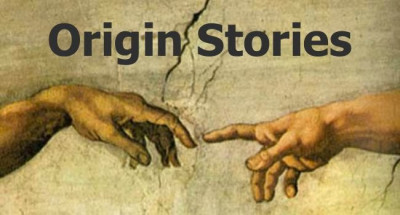 But what about recruitment?
But what about recruitment?
Well, Doctor Shay’s insight is that the qualities employees (or troops) seek in a leader are the same qualities people demand from heroes — the qualities every successful genesis story must cover:
Aristotle goes on to say what the troops are looking for in a leader. What makes the leader trustworthy in their eyes? Aristotle provides another triad. The troops extend trust to someone whose explanations (what he called “arguments”), training exercises, and decisions provide evidence for
- Professional competence, spirited personal integrity (aretê)
- Intelligent good sense, practical wisdom (phronêsis)
- Good will and respect for the troops (eúnoiâ)
And this insight is crucial not just to effective branding, but recruiting as well.
For what the customer instinctively wants is to do business with a company that’s led by a heroic personality: an honest man who stands behind his work and takes personal responsibility for delivering the honest goods to customers — a “the buck stops here” kind of leader.
And what employees want is to work for a boss who has those exact same qualities: an honest man who stands behind his people and takes personal responsibility for their work environment and quality of life/career.
This is why character and story-driven advertising not only accelerates branding success, but recruiting success as well.
Going Deeper — Avoiding Common Branding Mistakes
 One common misinterpretation of Wizard-inspired emphasis on character and story-driven branding is to denigrate so-called reason-why advertising.
One common misinterpretation of Wizard-inspired emphasis on character and story-driven branding is to denigrate so-called reason-why advertising.
Granted, using reason-why instead of or in place of character and story is usually a bad move. Even when it works, its success will prove vanishing, as most true USPs are easily and quickly copied.
But reason-why used with character and story is critical. Remember, as Dr. Shay pointed out, character, emotion, and logic are interrelated.
And on that note, I’ll quote some more from Dr. Shay himself:
“The centrality of rational explanation (“argument”)… shows the leader’s respect for the troops, who are his or her fellow citizens. You can’t separate respect from good will. What reasons, examples, and maxims the leader chooses from the infinity available, provide evidence for phronêsis and aretê. The persuasive power that comes when a leader appeals to reason comes more from the degree to which it provides evidence for the leader’s respect toward the troops than from the power of reason to compel assent, or having compelled assent, to guide or restrain behavior.”
Simply substitute “business owner” for leader and “audience” for troops, and this becomes a master class in advertising.
Smart advertisers include a healthy amount of appeals to reason and intellect in their branding, not in an attempt to compel the audience through cogent reasoning, but as a display of respect for the audience.
As the King of Madison Avenue himself once said:
“The customer is not a moron. The customer is your wife.” — David Ogilvy
Even among my Wizard of Ads colleagues, who similarly believe in the power of character and story-driven ads, I’m known for fervently avoiding a certain style of whacky, “snappy-gags-and-chatter” dialogue-driven ads.
I almost always prefer to have the owner(s) speaking directly to the audience, sincerely and from the heart, while including a healthy amount of reason-why in the messaging.
Here’s an example of this kind of advertising:
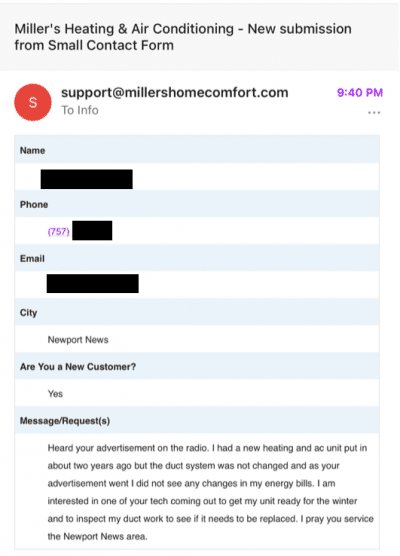 Is there a healthy amount of reason-why in that ad?
Is there a healthy amount of reason-why in that ad?
Absolutely.
But the reason-why is presented as a manifestation of personal integrity on the part of the owner combined with an inherent attitude of respect for the customer.
And, yes, listeners do understand and respond to this style of ad.
So my decisions to lean heavier on sincerity and reason-why content over whacky entertainment are driven by Dr. Shay’s insight about communicating respect towards the audience.
Specifically, I find that the two key ways of communicating that respect are:
- Vulnerable Self-disclosure, and
- Appeals to audience character and reason
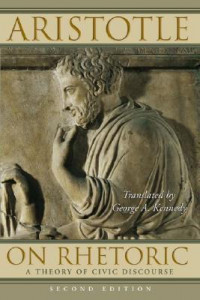 And both methods are quite difficult (though not impossible) to pull off via whacky ads and glib dialogue.
And both methods are quite difficult (though not impossible) to pull off via whacky ads and glib dialogue.
Too many ad professionals want their ads to come off as a lovable puppy.
And to be fair, that’s certainly not a bad way to go.
You could do a lot worse than having your audience always happy to hear your ads while finding you immensely likable.
But that’s not truly the essence of what people want in a leader or hero, is it?
Taking it to “Boss Level”
If you really want to take this insight beyond “advanced” to “boss level” — if you want to get at the essence of leadership that attracts customers and employees — you have to understand thumos.
Again, I’ll let Dr. Shay explain:
So as Aristotle famously says in Rhetoric I.ii.3, it is the ethos, the character of the leader that is most compelling to the troops. I want to connect the old Homeric word thumos to what I now want to say about character. This word is most often translated by the single word “spirit.” In modern times this has become rarified and if you forgive the play on words, spiritualized, so that we lose the sense that is still preserved when we speak of a horse as spirited or an argument as spirited. Professor Rorty at Brandeis gave me her best shot at translating the word as “the energy of spirited honor.” I want you to listen to Aristotle’s explanation of thumos in Politics VII.6.1327b39ff. He says, “Thymos is the faculty of our souls which issues in love and friendship….It is also the source … of any power of commanding and any feeling for freedom.”
The spirited self-respect that Homer called thumós becomes particularly critical to leadership in a combat situation. To trust the leader, the troops need to feel that the leader is his or her “own person,” not a slave.
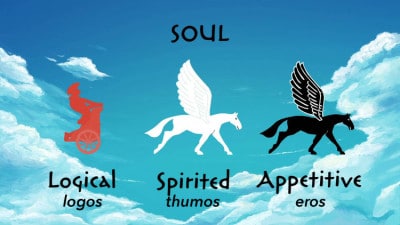 Now, many would argue that military analogies are poisonous to advertising — that one should be seducing customers rather than waging a campaign against adversaries — and this generally represents wise counsel.
Now, many would argue that military analogies are poisonous to advertising — that one should be seducing customers rather than waging a campaign against adversaries — and this generally represents wise counsel.
But… if you substitute “combat situation” for “environment of uncertainty, unease, and volatility,” then you’ll understand why thumos would be attractive to both customers and employees in today’s cultural and political environment.
And the larger point is that one can’t exhibit thumos while playing the part of a puppy or court jester.
One can only exhibit thumos while taking a firm stand against something. By having a line that one will not allow to be crossed. By a spirited defense of something to include vigorous attacks on all that threatens that thing.
Take a listen to the following ad, and you’ll hear the owner’s thumos radiating from your speakers:
That wasn’t a recruitment ad, per se, but it ended up recruiting quite a few first-rate plumbers and techs over to my client.
Now, in advertising, this must be handled delicately. You don’t want to come off as unduly negative, defensive, or bitchy.
But letting your audience know what you stand against and what industry norms you disagree with is an excellent way of conveying thumos.
In other words, naming all the ways that you’re your own man (or woman) effectively conveys your thumos, and so powerfully attracts both customers and employees.
More Than One Way to Skin a Cat
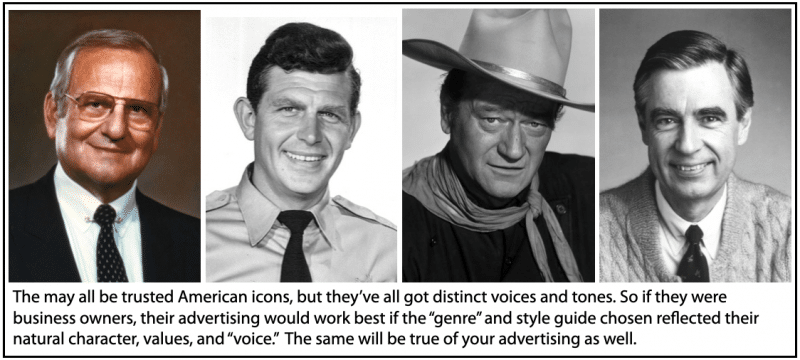
So I’ve thrown more than a little shade at the “snappy gags and chatter” style of dialogue-driven advertising.
But I’ve also tried to give it its due.
The truth is that there’s more than one way to effectively brand a company.
And the smart marketer will match the style of a proposed ad campaign to the style of the business owner.
And yet, it’s also up to the business owner to select an ad team whose “house style” matches his own personal style and preferences.
The advertising style that I’ve advocated for in this article is certainly not for every business owner.
I’d even suggest that many owners might prefer a witty-banter/feel-good advertising strategy.
And such a business owner would probably be better of working with one of my many talented colleagues who do that kind of advertising brilliantly.
Then again, there are other business owners that might well feel the thumos in their own souls and wish for an ad campaign that expressed that.
And those owners might be best served by an ad consultant capable of crafting an ad campaign that would honor that thumos.
If you’re in that latter camp, I just might be the perfect fit. Why not reach out and find out?
- Are You Paying for Too Much for the Wrong Keywords? - July 15, 2024
- Dominate Your Market Like Rolex — 4 Powerful Branding Lessons - July 3, 2024
- Military-Grade Persuasion for Your Branding - June 25, 2024

